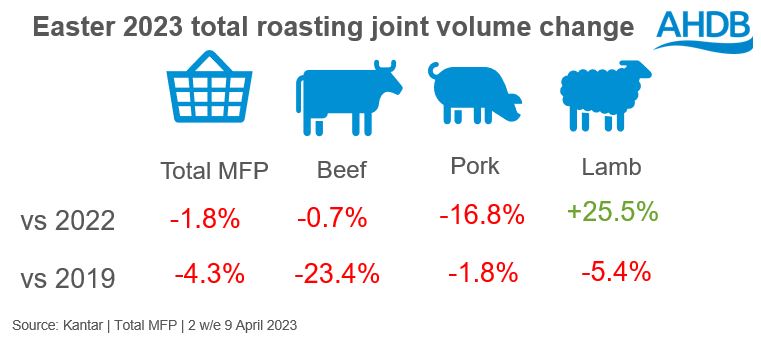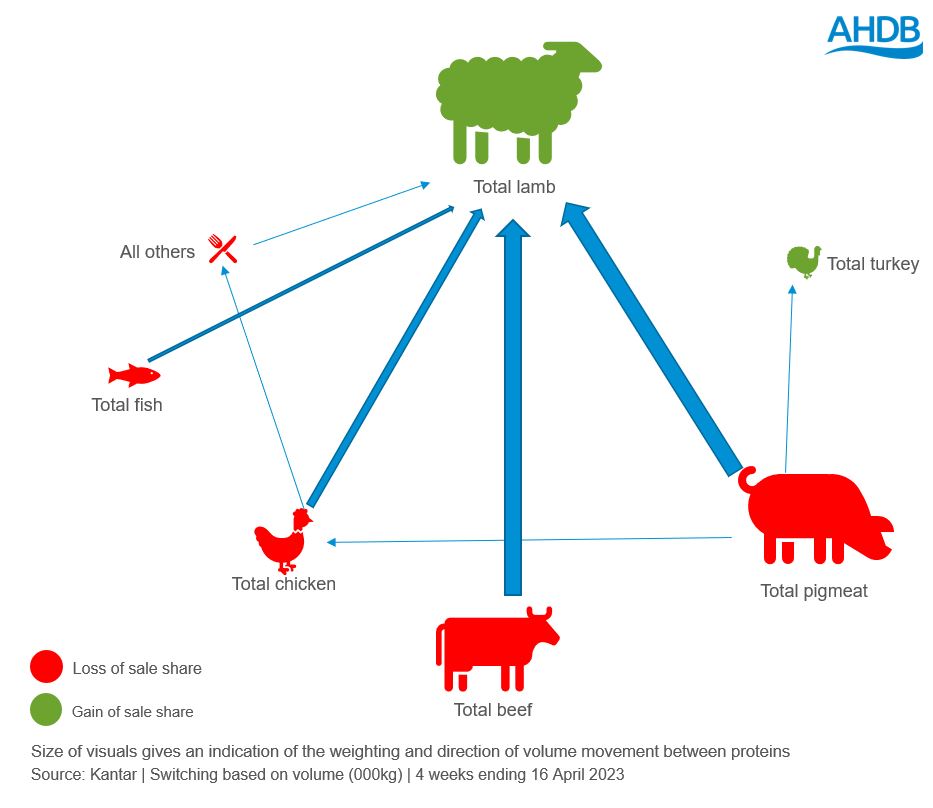Cracking Easter for lamb
Wednesday, 17 May 2023
Easter is one of the first bank holidays of the year and a chance for families and friends to get together to celebrate; an event usually centred around food and treating.
In the minds of shoppers, Easter is heavily associated with specific food and drink, coming second only to Christmas (IGD Research 2023). Easter is also synonymous with family time and eating at home, with just 12% of consumers indicating that they would go out to celebrate (IGD, 2023). This is reflected in out-of-home penetration remaining relatively static year-on-year with pub and bar occasions, and therefore Easter roasts out-of-home losing to the value end of the market and quick service retail (Lumina, EDOP 4 w/e 16 April 2023).
This year the cost-of-living crisis remains at the forefront of many consumers’ minds, with inflation in double figures for the 10th consecutive month, topping 17.3% in the four weeks to 16 April. This Easter was also the first following the introduction of HFSS restrictions in England. Despite this, data from Kantar indicates that the nation indulged in Easter treats and continued to embrace the occasion by purchasing 38 million chocolate eggs in the week prior to Easter, an additional 5 million compared with last year. Hot cross bun sales also increased by 5%.
Lamb boosts roasting performance
The importance of the Easter roast was well supported by retailers, with many this year pushing promotions to meet the consumer need for value for money. Marketing both online and instore for many retailers featured imagery of Easter lunch, with centre piece proteins front and centre. This, coupled with slightly unsettled weather this year versus previous, meant more consumers opted for a traditional celebration, choosing the classic roast for their Easter lunch.
The latest data, according to Kantar, shows that in the two weeks leading up to Easter (ending 9 April), 9.7 million kg of roasting joints were sold through retailers. This is up 6.0% on last year, and outperforms the overall meat, fish, and poultry (MFP) category which saw a 1.8% decline on 2022 (Kantar World Panel). This uplift, however, is due to the performance of lamb.
Lamb roasting joints performed particularly well this year, seeing an overall 25.5% increase in volume sales on last year as well as increasing their presence in UK households by 1.9ppt (Kantar, 2 w/e 9 April 2023). Of this, leg roasting joints accounted for almost 93% of all lamb roasting joints sold this Easter, and 62% of all lamb sold during the period.
Despite commanding the highest average price per kilo of the red meats in the 12 w/e 16 April, lamb has seen the smallest price increase in this time, up 9.9% compared with 10.8% and 13.4% uplifts for beef and pork respectively (Kantar World Panel). Promotional activity around lamb at Easter was well supported by retailers. In the two w/e 9 April, volumes of MFP sold on promotion accounted for 25.8% of total purchases. Lamb, however, saw 42.9% of its volumes sold on promotion. This may have helped convince consumers to treat themselves to lamb for their celebratory lunch, and switching to the category was seen from all other proteins.
Traditionally, lamb is associated as a favourite with older consumers (older dependents, empty nesters, and retirees), and whilst they still account for over 75% of total lamb sales in the two w/e 9 April 2023, the largest uplift in purchases were seen in the middle family demographic, where there was a 22.3% increase during the peak purchasing period compared with last year. Previous research has shown the importance of pester power, and the treatiness associated with lamb particularly for younger demographics, and highlights that consumers were really getting behind the celebratory sentiment surrounding Easter.
There may have also been heightened demand for lamb with Ramadan and Eid falling around the Easter period. AHDB research has indicated that supermarkets are becoming more popular for Muslim consumers, particularly with younger generations, as they are looking for cheaper alternatives to butchers during the cost-of-living crisis.
Despite lamb seeing switching from other red meat roasting joints, we also saw a boost in gammon volumes up 28.4% year-on-year and 13.9% versus pre-COVID. Gammon provides an alternative roasting option at a lower average price point than both lamb and beef, perhaps catering to the more price conscious consumer who fancied a change to the traditional roasting joints.
Unpredictable weather challenges BBQs
The unsettled weather over the long weekend may have stunted the start of BBQ season, resulting in year-on-year losses seen for beef and pork steaks, and beef burgers. Uplifts were however seen for sausages, up 0.3% on last year and 4.0% on 2019, likely due to consumers moving to indoor dining and comfort meals such as bangers and mash to combat the weather.
Considerations for Easter 2024
Last year, we said considerations should be made to remind consumers of the traditional celebratory roast, as well as inspiring younger consumers beyond chicken. It is clear that this year this was managed and resulted in a bumper year for lamb roasting joint sales. To capitalise on the gains seen this year for both lamb, and roasting overall, retailers should continue to support promotions as well as providing reminders to consumers of the seasonal importance of lamb to maintain momentum and volume sales. Retailers should also look to cater for BBQs and outdoor dining if weather dictates.
Note – Easters are compared to equivalent Easters in previous years due to the event moving on an annual basis

Sign up to receive the latest information from AHDB
While AHDB seeks to ensure that the information contained on this webpage is accurate at the time of publication, no warranty is given in respect of the information and data provided. You are responsible for how you use the information. To the maximum extent permitted by law, AHDB accepts no liability for loss, damage or injury howsoever caused or suffered (including that caused by negligence) directly or indirectly in relation to the information or data provided in this publication.
All intellectual property rights in the information and data on this webpage belong to or are licensed by AHDB. You are authorised to use such information for your internal business purposes only and you must not provide this information to any other third parties, including further publication of the information, or for commercial gain in any way whatsoever without the prior written permission of AHDB for each third party disclosure, publication or commercial arrangement. For more information, please see our Terms of Use and Privacy Notice or contact the Director of Corporate Affairs at info@ahdb.org.uk © Agriculture and Horticulture Development Board. All rights reserved.
Topics:
Sectors:
Tags:



